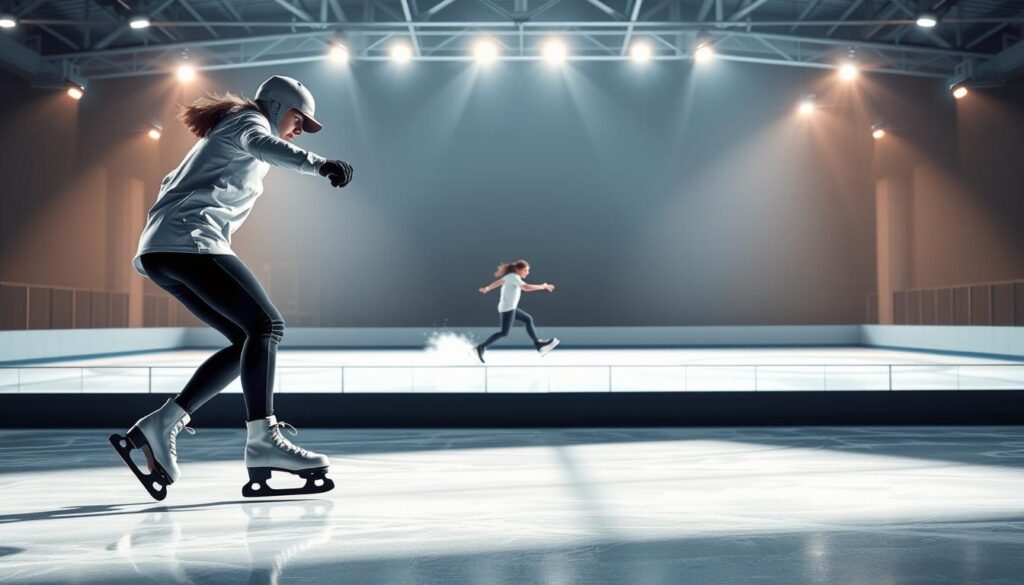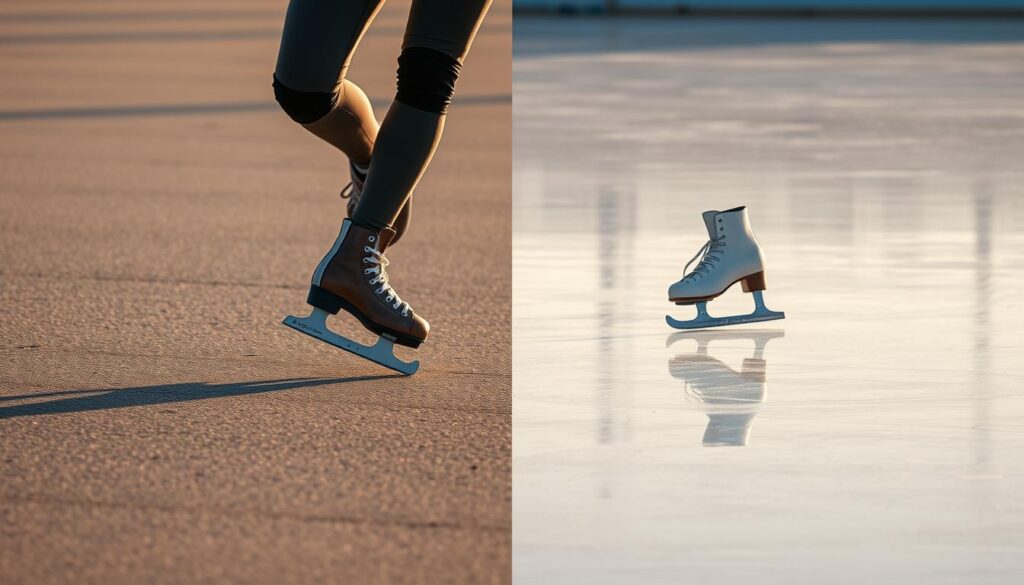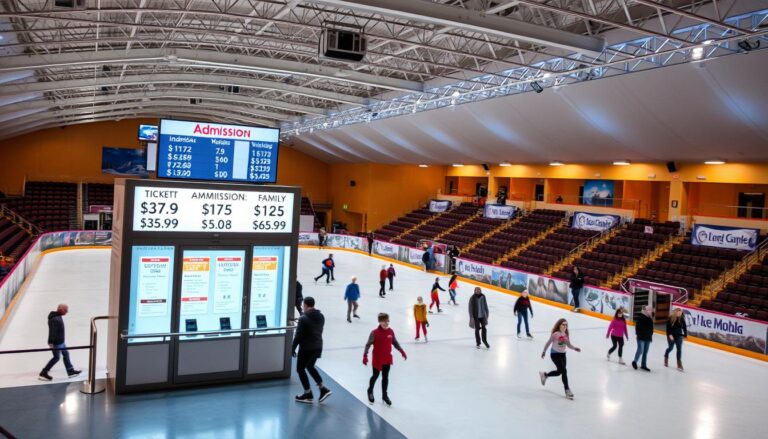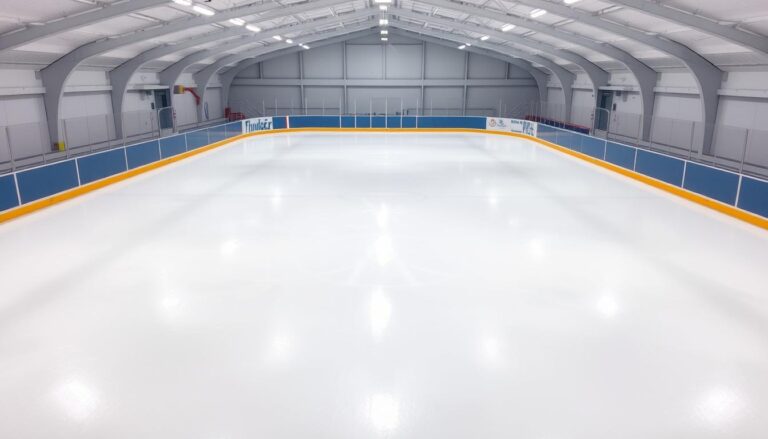Roller Skating vs. Ice Skating: Which is More Challenging?
Imagine gliding smoothly, your body moving in perfect sync. The debate on whether roller skating or ice skating is harder is fierce. To understand which is harder, we must look at the unique challenges each sport offers.
Is roller skating or ice skating harder? It’s not a simple answer. Both require balance, core strength, and technical skills. Roller skating faces you with more friction, while ice skating tests your precision on ice.
For beginners, the learning curve is steep. Roller skating starts with a stable feel, thanks to wheels that grip the ground. Ice skating, on the other hand, requires quick control over blades and balancing your weight. Your first tries will show the differences between these two sports.
Physical fitness is key in figuring out which sport is harder. Roller skating works different muscles than ice skating. The surface, gear, and how you move add to the challenge, testing your athletic skills.
Both sports are complex, loved by pros and hobbyists alike. The difficulty in roller skating vs ice skating isn’t just about technique. It’s about mastering body mechanics, surface interaction, and personal skill.
Starting your journey in either sport will be exciting and challenging. Whether you pick roller skates or ice blades, you’ll face physical and mental hurdles. You’ll get a great workout and grow as a person.
Are you ready to dive into the world of skating? Each style brings its own mix of fun, skill, and physical challenge. The real adventure starts when you step onto the surface and begin moving.
Understanding the Basic Mechanics of Both Sports
Exploring roller skating versus ice skating is a journey into physics, body mechanics, and movement. Each sport has its own set of challenges that make it unique.

Physics of Movement on Wheels vs. Blades
The main difference between roller skating and ice skating is how they interact with the surface. Roller skates use wheel friction, while ice skates glide on a thin blade. This difference affects how you move and stay balanced.
- Roller Skating: Requires constant friction management
- Ice Skating: Depends on blade precision and minimal surface contact
- Surface interaction determines overall skating dynamics
Core Body Mechanics Required
Each skating style needs different muscles and core strength. Roller skating focuses on lateral stability, while ice skating emphasizes forward-backward balance.
| Skating Type | Primary Muscle Groups | Key Movement Challenges |
|---|---|---|
| Roller Skating | Quadriceps, Glutes, Calves | Lateral stability, wheel control |
| Ice Skating | Inner Thighs, Core, Ankles | Blade precision, forward momentum |
Balance and Center of Gravity Differences
The most interesting part of comparing roller skating and ice skating is how they affect your balance. Ice skating needs a more centralized balance point, while roller skating allows for wider stances.
- Ice Skating: Narrow, precise balance
- Roller Skating: More flexible balance options
- Both require constant weight distribution adjustments
Knowing these mechanical differences helps skaters understand the unique challenges of each sport. Whether on wheels or blades, mastering the basic physics is essential for skill.
Is Roller Skating or Ice Skating Harder?
Skating fans often wonder which is tougher: roller skating or ice skating. It’s not just a simple yes or no answer. Both sports need special skills, balance, and coordination.

- Surface interaction plays a big role in how hard it is
- Equipment is different for each sport
- Physical needs change for each skating style
Roller skating starts with more muscle work. The wheels are less stable than ice blades. So, you need strong core muscles and good balance. Ice skating, on the other hand, needs precise edge control and can be very technical.
| Difficulty Factor | Roller Skating | Ice Skating |
|---|---|---|
| Initial Balance | More challenging | Slightly more stable |
| Surface Grip | Higher friction | Smooth gliding |
| Technical Skill | Easier entry-level moves | More complex techniques |
It really depends on your skills and experience. Some find roller skating tough because of the muscle work. Others struggle with ice skating’s precise moves.
So, what’s the best thing to do? Try both! Each sport has its own challenges and benefits. You’ll get better at balance, coordination, and fitness.
Learning Curves: First Steps on Wheels vs. Ice
Starting to skate is exciting but can also be scary. Whether you choose roller skating or ice skating, knowing the first steps is key. The first time you step on wheels or blades, you’ll see the difference.

Initial Balance Challenges
Balance is a big deal when you start skating. Roller skating is often easier because the wheels are wider and more stable. Ice skating, on the other hand, is harder because the blades are thin and require more balance.
- Roller skates offer more surface area for stability
- Ice skates require more precise weight distribution
- Surface friction differs dramatically between wheels and blades
Time to Basic Proficiency
Learning the basics takes time, but it’s faster with roller skating. Most people can skate a little in 1-2 hours. Ice skating takes longer, often 3-5 sessions to feel comfortable.
Common Beginner Mistakes
Skaters, no matter the surface, often make the same mistakes. Knowing these mistakes helps:
- Tensing up and becoming rigid
- Looking down instead of forward
- Failing to bend knees for better balance
- Incorrect weight distribution
Learning to skate is a journey for everyone. Some find roller skating easier, while others prefer ice. Your success depends on your comfort, strength, and practice.
Equipment Comparison and Impact on Performance

When we look at roller skating and ice skating, the gear is key. It affects how well you skate and how much fun you have. Each sport needs special equipment to help you move smoothly and comfortably.
At first, roller skates and ice skates seem the same. But, they are really different. Their design affects how you skate and the skills you need.
- Boot Construction: Roller skate boots are more flexible at the ankle. Ice skate boots are stiff for support
- Wheel/Blade Mechanics: Roller skates have wide, stable wheels. Ice skates have narrow blades
- Surface Interaction: Ice skates glide on ice. Roller skates roll on solid ground
Choosing the right gear is important. Professional skaters get custom-made gear to improve their skills. But, beginners can start with basic equipment that’s comfortable and supportive.
Keeping your gear in good shape is different for roller and ice skates. Roller skates need their wheels changed and bearings greased often. Ice skates need to be sharpened and adjusted to skate well.
| Equipment Feature | Roller Skates | Ice Skates |
|---|---|---|
| Boot Flexibility | High mobility | Rigid support |
| Surface Contact | Rubber/polyurethane wheels | Metal blades |
| Maintenance Frequency | Every 3-6 months | Professional check every season |
Knowing about the gear helps skaters choose better. It can improve their skills and fun in skating.
Surface Differences and Their Effect on Skating
Knowing what you skate on is key when you compare roller and ice skating. The surface you skate on changes your experience, how you improve, and how hard it is.
Skating surfaces pose unique challenges that affect how hard roller skating or ice skating is. Each surface needs different skills and techniques from skaters.
Ice Rink Conditions and Challenges
Ice rinks offer a smooth but tricky surface for skaters. The surface can change due to:
- Temperature and humidity impact ice quality
- Skater traffic creates uneven patches
- Blade marks and scratches alter surface texture
Ice skating is more dynamic than roller skating. Ice rinks use special cooling systems to keep the surface even. But, natural changes can happen.
Roller Skating Surface Variables
Roller skating surfaces are more varied than ice rinks. Skaters might find:
- Smooth indoor wooden floors
- Concrete outdoor paths
- Asphalt trails
- Specialized skating rink surfaces
Each surface needs different skills and techniques. Outdoor roller skating adds challenges like uneven surfaces, debris, and unexpected changes. These make roller skating more complex in terms of adapting.
In the end, how hard roller skating or ice skating is depends on your skill, the surface, and how well you adapt. Both sports require unique skills and offer exciting challenges for fans.
Muscle Groups and Physical Demands
Roller skating and ice skating are two sports that challenge your body in different ways. They engage various muscle groups, making it hard to say which is more challenging. Each sport has its own unique physical demands.
Ice skating focuses on core stability and lower body strength. Roller skating, on the other hand, works a wider range of muscles. This makes roller skating a full-body workout.
- Core Muscles: Both sports demand significant core engagement for balance and control
- Ice skating emphasizes quadriceps and inner thigh muscles
- Roller skating provides more full-body workout
When comparing roller skating and ice skating, the muscle activation patterns are quite different. Ice skaters need precise leg movements and strong ankle stabilization. Roller skaters, on the other hand, use dynamic muscle groups for balance and momentum.
Many say roller skating is harder for beginners because of the unpredictable surfaces. It requires adjusting body positioning and using more muscles.
Both sports offer great cardiovascular benefits. They improve strength, endurance, and flexibility. Your choice between roller skating and ice skating depends on your fitness goals and preferences.
Stopping Techniques and Safety Considerations
Learning to stop safely is key when comparing roller skating and ice skating. Whether you’re on wheels or blades, knowing how to stop fast is vital. It helps prevent injuries and boosts your confidence.
Stopping is a big challenge in both roller skating and ice skating. Each sport needs its own skills and techniques to control speed and keep riders safe.
Emergency Stopping Methods
When looking at roller skating versus ice skating, stopping is very important. Here are some emergency stopping methods:
- Roller Skating Emergency Stops:
- T-Stop method
- Heel brake technique
- Toe stop drag
- Ice Skating Emergency Stops:
- Snow plow stop
- Hockey stop
- Parallel stop
Advanced Braking Techniques
Advanced skaters use more complex stopping methods. These require precise body control and muscle coordination.
| Skating Type | Advanced Stopping Technique | Difficulty Level |
|---|---|---|
| Roller Skating | 180-degree spin stop | Advanced |
| Ice Skating | Controlled edge stop | Expert |
Pro tip: Practice these techniques in a controlled environment with proper protective gear to build confidence and skill.
Safety is always the top priority in both roller skating and ice skating. Wearing helmets, knee pads, and wrist guards can greatly reduce injury risks during unexpected stops.
Speed and Momentum Control Differences
Speed control is different in roller skating and ice skating. Each sport has its own challenges in managing momentum. This makes one sport harder than the other.
Knowing how to control speed is key for skaters. They need to figure out which sport is more technical. Roller skating and ice skating require unique ways to move fast.
- Ice skating offers smoother acceleration due to minimal surface friction
- Roller skating requires more precise weight distribution for consistent speed
- Blade edges provide more stability during speed transitions on ice
- Wheel configuration impacts momentum control in roller skating
Momentum control is very different in these sports. Ice skaters use blade edges for powerful glides. Roller skaters face changing surfaces that affect their speed.
| Speed Control Factor | Ice Skating | Roller Skating |
|---|---|---|
| Surface Friction | Minimal resistance | Higher friction variations |
| Stopping Technique | Sharp blade edge stopping | Toe stop or heel brake |
| Speed Potentia | Smoother acceleration | More effort required |
Ice skating is harder in terms of speed control, with more advanced challenges. Roller skating needs body awareness and technique to stay fast on different surfaces.
Experts say mastering core muscles and weight distribution is essential. These skills help conquer speed in both sports.
Impact on Joints and Long-term Physical Effects
Skating fans know that roller skating and ice skating have different effects on joints and physical health. Both sports require a lot of physical effort. But, they affect the body in different ways.
Looking at the joint stress of roller skating and ice skating shows some big differences. The surface and the equipment used are key in how they affect the body over time.
Joint Stress Analysis
Knowing how each skating style works helps athletes avoid injuries. Roller skating puts more stress on the ankles and knees. Ice skating, on the other hand, is smoother and puts less stress on these areas.
| Skating Type | Joint Stress Level | Primary Stress Areas |
|---|---|---|
| Roller Skating | High | Ankles, Knees |
| Ice Skating | Moderate | Hips, Lower Back |
Injury Prevention Strategies
- Develop core strength for better stability
- Use proper protective gear
- Practice regular stretching routines
- Invest in high-quality skating equipment
Athletes can lower joint stress by using specific training methods. Proactive conditioning and technique refinement are key to avoiding long-term joint problems.
Skaters suggest cross-training and slowly improving skills to keep joints healthy. This way, they can enjoy both roller and ice skating without worrying about injuries.
Cost and Accessibility Factors
Choosing between roller skating and ice skating is more than just skill. It also involves money and where you live. Knowing the costs and where to skate can help you decide which sport is right for you.
Equipment costs are a big deal for both sports. Roller skating gear is usually cheaper than ice skating. A basic roller skate costs between $50 and $150. Ice skates start at $100 and can go up to $500 for top-quality ones.
| Cost Factor | Roller Skating | Ice Skating |
|---|---|---|
| Entry-Level Equipment | $50 – $150 | $100 – $500 |
| Monthly Facility Fees | $10 – $30 | $20 – $50 |
| Maintenance Costs | Low | Moderate |
Where you live affects your options. Is roller skating or ice skating harder to find? Roller skating is easier to find, with options indoors and outdoors. Ice skating needs special rinks, which might not be available year-round in warm places.
- Roller skating venues are more widespread
- Ice skating often requires dedicated indoor facilities
- Community centers frequently offer affordable skating programs
Skaters on a budget can look into renting, community classes, and group deals. Many parks and recreation departments offer cheap skating for beginners. This lets you try out either sport without spending a lot.
Professional Training Requirements
Aspiring skaters face complex training landscapes in roller skating or ice skating. Knowing the certification and skill paths helps decide which is more challenging.
Training for roller skating and ice skating is very different. Each needs its own way to develop skills and get coaching certifications.
Coaching Certification Pathways
To become a pro instructor, skaters must go through tough certification steps. The paths for roller skating and ice skating are unique:
- Roller Skating Certification Requirements:
- United Skateboarding Association (USA) training
- Minimum skill level testing
- Pedagogical workshop completion
- Ice Skating Certification Requirements:
- U.S. Figure Skating Association programs
- Multiple skill level assessments
- Comprehensive coaching education
Skill Progression Levels
Deciding which is harder between roller skating and ice skating depends on your skill path:
| Skill Level | Roller Skating | Ice Skating |
|---|---|---|
| Beginner | Basic balance and movement | Fundamental gliding techniques |
| Intermediate | Advanced turns and stops | Complex edge work |
| Advanced | Artistic and speed techniques | Competitive jumps and spins |
Professional skating training needs dedication, technical skill, and ongoing learning. Whether in roller skating or ice skating, becoming skilled takes passion and constant practice.
Competitive Aspects and Skill Ceiling
Competitive skating tests athletes to their limits, showing key differences between roller and ice skating. The competitive world of each sport has its own unique challenges and skill needs. This makes each sport stand out in its own way.
Top athletes in both roller and ice skating train hard to get better. Roller skating has many competitive areas, like:
- Artistic roller skating
- Roller derby
- Speed skating on wheels
- Freestyle performance
Ice skating has its own special areas for competition:
- Figure skating
- Speed skating on ice
- Short track racing
- Synchronized team skating
It’s hard to say which is tougher, roller skating or ice skating. It really depends on the athlete’s skills and the type of competition. Both sports require top physical and mental fitness.
| Competitive Aspect | Roller Skating | Ice Skating |
|---|---|---|
| Physical Demands | High friction, more muscle control | Low friction, precise blade control |
| Technical Complexity | Complex ground-based maneuvers | Intricate aerial and spinning techniques |
| Olympic Recognition | Limited international competitions | Established Olympic sport |
Pro athletes in both sports invest thousands of hours perfecting their craft, demonstrating remarkable dedication and skill development.
Environmental Adaptability and Limitations
Skating fans know the environment greatly affects their experience. Whether on roller skates or ice skates, knowing the environmental challenges is key. It helps decide which sport might be harder for you.
Roller skating and ice skating face different environmental challenges. Each sport has its own set of challenges that can affect your performance and fun.
Weather Impact on Skating Sports
Weather conditions affect roller skating and ice skating differently:
- Roller skating needs:
- Dry, smooth surfaces
- Moderate temperatures
- Minimal wind conditions
- Ice skating requires:
- Controlled temperature environments
- Maintained ice surfaces
- Consistent humidity levels
Venue Requirements and Limitations
The venue greatly affects which skating sport is harder. Ice skating needs special indoor rinks with precise temperature control. Roller skating, on the other hand, offers more flexibility with various surface options.
Outdoor roller skating offers more environmental versatility. But, it comes with its own challenges. Smooth pavements, park trails, and specialized skating areas are your playground. Ice skating, in contrast, relies almost exclusively on purpose-built indoor venues.
When comparing roller skating or ice skating which is harder, environmental adaptability is key. Each sport demands unique skills and presents different environmental challenges. These challenges can test even the most experienced skaters.
Cross-Training Benefits Between Both Sports
Skating fans find a world of athletic versatility when they compare roller and ice skating. These two sports share surprising similarities. These similarities can greatly improve your skating skills.
Skills from roller and ice skating blend together in unique ways. This creates special cross-training chances. Skaters can work on balance, edge control, and body awareness by using techniques from both sports.
- Core muscle engagement remains consistent across both skating styles
- Balance and proprioception skills transfer seamlessly between surfaces
- Lower body strength develops similar in roller and ice skating
Specific exercises can help skaters reach their full skating ability. Dryland training techniques are key for keeping muscle memory sharp during breaks. They help maintain technical skill.
| Skating Discipline | Transferable Skills | Cross-Training Benefits |
|---|---|---|
| Roller Skating | Lateral movement | Improved ice skating agility |
| Ice Skating | Edge control | Enhanced roller skating precision |
| Both Disciplines | Balance and coordination | Overall athletic performance |
Many pro skaters mix roller and ice skating into their training. They learn the detailed complexity of each sport. This helps them build a wide range of skills that go beyond traditional sports.
Social and Cultural Aspects of Both Activities
Skating is more than just moving around. It’s a way to connect with others across different ages. Whether you’re into roller skating or ice skating, both offer rich cultural experiences.
Skating creates its own special communities. Roller skating is often seen as fun and energetic, attracting those who love to dance. Ice skating, on the other hand, is about elegance and mastering skills.
- Roller skating communities are inclusive and full of energy
- Ice skating groups focus on technical skills and competition
- Both sports have strong social networks for fans
Looking at roller skating vs ice skating, we see different cultural impacts. Roller rinks host dance nights and community events. Ice rinks focus on training and performances.
Being part of these sports is more than just the skills you learn. Skaters connect through:
- Group lessons and training
- Local skating clubs
- Competitions at the regional and national levels
- Online communities and social media
Skating communities are welcoming to everyone. They help break down barriers, bringing people together from all walks of life. Whether you’re curious about roller skating or ice skating, the real joy is in the friendships you make.
Conclusion
After exploring the differences between roller skating and ice skating, we see that each has its own challenges. It’s hard to say which one is more difficult. Both require special skills, physical strength, and mental focus.
Our detailed look at roller skating vs ice skating shows that success depends on many things. These include your physical abilities, the resources available to you, and your passion for the sport. Each type of skating offers its own thrill, technical challenges, and chances to grow as a person.
The real joy of skating isn’t just about the surface you’re on. It’s about feeling free, facing physical challenges, and finding a community. Both roller skating and ice skating offer great ways to stay fit, learn new skills, and have fun. Your skating journey is a personal adventure. So, grab your skates and start exploring your abilities.
Are you ready to start your skating journey? Whether you choose wheels or blades, remember that every pro began as a beginner. The most important thing is to begin and keep working on your skills. Share your skating goals and experiences in the comments below. We can’t wait to hear about your adventure!






